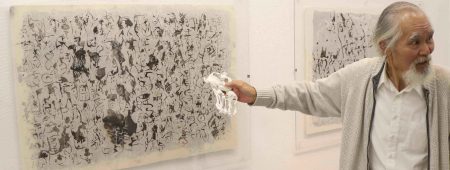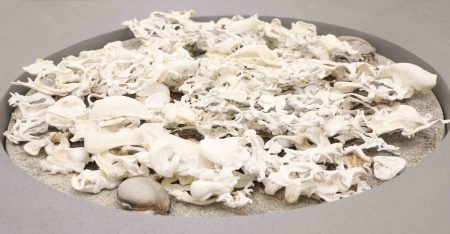The knowledge imposes a pattern, and falsifies,
For the pattern is new in every moment
And every moment is a new and shocking
Valuation of all we have been.
—TS Eliot, (East Coker)
There is a strange universe. It contains everything imaginable between the limits of stone and sun—the extremities of all that has ever occurred and could again.
In that universe there are forms, monads, tracks left behind of life that once existed, but no trace of that life itself. It has disappeared entirely. These forms are no more than shadows, imprints, marks, fossils, signs that may be exchanged. They are forms that simultaneously bring awareness and alienate.
In his latest exhibition at Ginza’s Natsuka Gallery (October 23—28, 2017) Fukui formative artist Tatsuya Tatsuta challenges the formal constraints of language.
In search of an ancient root for his deconstruction theory, Jacques Derrida notably goes after the indeterminacy of the pharmakon—the Greek word that at once signifies medicine, poison and scapegoat. But it is perhaps in the Egyptian god of the hieroglyph and all writing, Thoth, whom the Greeks adopted as Hermes, that Derrida’s conceptual thrusts have their farthest reach. “The god of writing is,” Derrida posits in Dissemination, “at once his father, his son, and himself.” Thoth, associated with maintaining balance in the universe, of laying the plans for the heavens, stars and earth “has neither a proper place nor a proper name… [but a] floating indetermination that allows for substitution and play.” He is, to Derrida’s Plato, the inventor of play. For play, we should read spontaneity of movement, or “every act marked by unstable ambivalence.”
Burned in pyromantic divinations by the ancient Chinese of the Shang Dynasty, plastrons of turtle shell and ox scapulae engraved with rounded pictograms represent the earliest extant records of Chinese script. By 1100 BC, one hundred years later, this oracle bone script known in Japanese as koukotsu moji (甲骨文字) was being carved into bronze from which evolved the Chinese script of today and the backbone of several of Asia’s written languages, among them Japanese.
Transcribed from Fukui koukotsu moji scholar Shizuka Shirakawa’s reference catalog onto Japanese paper (washi), then drenched in water and immediately scorched by Fresnel Lens-focused sunrays reaching 2000 OC (a typical ceramics oven goes to 1,200‑1,500 OC). These ancient pictograms are seared to negative space and their form is simultaneously warped to partial misrecognition. Almost like a step backwards on the evolutionary timeline, the characters seem to be approaching nearer to the truth they were first created to represent: a bridge or a thrust into an undocumented past.
In theatre art, Antonin Artaud famously championed an intense opposition to common language as a shield to truth in aesthetic experience. It infected many who came into Artaud’s sphere. The brittle bottle of words was to be smashed in his Theatre of Cruelty as a necessary violence to engage the audience, enmesh them in the work, ruin their complacency.
A “syncretic blend” of Thoth and Hermes having been recognized in Artaud’s works, it is not surprising that Derrida should have been drawn to the theater theorist and contradictory figure, one that was an “embodiment of both an aggressive and repairing gesture.” Indeed gesture, for Artaud was the key means of shattering the glass of language. Visual force of the gesture could also be brought to bear in language written on paper using burn marks, smears and other non-verbal supplements. Artaud’s spells—handwritten letters to friends intended to curse or protect them—are burned or otherwise violently marked (supplemented) with hieroglyphs, lines or smears (exemplified in the Spell for Roger Blin, Samuel Beckett’s debut theatrical impresario). Implicit in these emphatic gestures is the understanding that conventional words alone are not adequate to raise the clarity of the message.
“Sometimes,” wrote Artaud, turning to drawing late in his life, “besides human heads I sent for objects, trees or animals because I am not yet sure of the limits which the body of me, human, can finally reach. Anyway I have definitely broken with art, with style and with talent in all the drawings you will see here. I mean, woe to he who considers them as works of art, as works of simulation and the aesthetic of reality. None of them is, properly speaking, a work. All are sketches. I mean they are probes, thrusts into every channel of hazard, of possibility, of chance or destiny.
In the center of the Natsuka Gallery two horizontal exhibits are set out side by side on equally sized tables. One of them, says Tatsuya, is the soul of Re-Monad (the title of his 2017 exhibition at National Art Center Tokyo: http://www.kyotojournal.org/kyoto-journal-87/). The ‘soul’ is a pile of white heat-transformed polystyrene pieces that, he points out, mirrors the Chinese oracle bone script mounted on the surrounding gallery walls. The pile of monad pieces is clearly bounded within the rim of a pit.
Counterpoised with this, the other exhibit resembles a nest of eggs, a honeycomb of larvae, an order of embryonic incubation, and it is spilling over. A piece of scrap concrete turned upside down cradles the metal and stone zygotic transforms. For each ‘egg’, individually cupped, the acrosome reaction has been catalyzed by 2000 OC of solar energy.
This binary tableau amidst the wall-mounted koukotsu moji plates is decidedly metempsychotic, rinnetenshou (輪廻転生): an opposition of death—the bone-white and empty monad forms, and life—the dense and substantial embryonic forms.
Thoth, for Derrida, “this god of resurrection, is less interested in life or death than in death as a repetition of life and life as a rehearsal of death, in the awakening of life and in the recommencement of death.”
The inescapable ambiguity of language, the constraints of its phonetic redundancy and semantic logic, and the desire to overcome it, seems to lie at the heart of this work and exhibition. Nevertheless, Tatsuya is quick to draw pleasure from the play this can offer: the existence, in Japanese, of a homophone (恍惚) of oracle bone script. Koukotsu, spoken or written in Roman, also denotes ecstasy.
George Saitoh was born in Ireland. His drama, essays, fiction and poetry have appeared in Kyoto Journal, Aeqai, Word Riot, Clarion, Orbis, Santa Ana River Review and Janus Head. His plays have been staged in Tokyo and Dublin. He lives in Tokyo and teaches at Waseda University.
www.georgesaitoh.com









